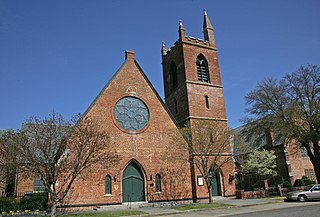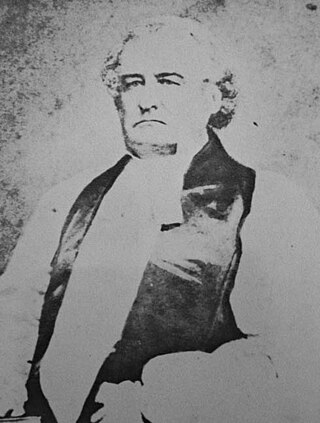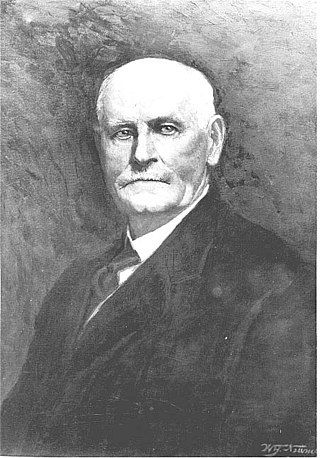
Lieutenant-General Leonidas Polk was a bishop of the Episcopal Diocese of Louisiana and founder of the Protestant Episcopal Church in the Confederate States of America, which separated from the Episcopal Church of the United States of America. He was a planter in Maury County, Tennessee, and a second cousin of President James K. Polk. He resigned his ecclesiastical position to become a major-general in the Confederate States Army, when he was called "Sewanee's Fighting Bishop". His official portrait at the University of the South depicts him as a bishop with his army uniform hanging nearby. He is often erroneously referred to as "Leonidas K. Polk," but he had no middle name and never signed any documents as such.

The Alabama State Capitol, listed on the National Register of Historic Places as the First Confederate Capitol, is the state capitol building for Alabama. Located on Capitol Hill, originally Goat Hill, in Montgomery, it was declared a National Historic Landmark on December 19, 1960. Unlike every other state capitol, the Alabama Legislature does not meet there, but at the Alabama State House. The Capitol has the governor's office and otherwise functions as a museum.

St. John's Episcopal Church, Lafayette Square is a historic Episcopal church located at Sixteenth Street and H Street NW, in Washington, D.C., along Black Lives Matter Plaza. The Greek Revival building, designed by Benjamin Henry Latrobe, is adjacent to Lafayette Square, one block from the White House. It is often called the "Church of the Presidents".

Christ Church is an Episcopal church located at 118 North Washington Street, with an entrance at 141 North Columbus Street, in Alexandria, Virginia. Constructed as the main church in the Church of England's Fairfax Parish, the building was designed by Col. James Wren, a descendant of Sir Christopher Wren.

Nicholas Hamner Cobbs was a minister and evangelist of the Episcopal church who served as the first Bishop of Alabama from 1844 to 1861.

Government Street Presbyterian Church in Mobile, Alabama is one of the oldest and least-altered Greek Revival church buildings in the United States. The architectural design is by James Gallier Sr., James H. Dakin, and Charles Dakin. The trio also designed Barton Academy, four blocks down Government Street to the west. Government Street Presbyterian reflects the influences of Ithiel Town, Minard Lafever, and Andrew Jackson Downing. It was declared a National Historic Landmark in 1992.

St. Paul's Episcopal Church is an historic red brick Gothic Revival church located at 210 Lauderdale Street in Selma, Dallas County, Alabama, United States. The parish was established in 1838 and its original sanctuary building was burned on April 2, 1865 during the Battle of Selma, with credit for that act going to Union General James H. Wilson. The current building was designed by the famous New York City architectural firm of Richard Upjohn and was completed in 1875.

The Church of the Epiphany, built in 1844, is an historic Episcopal church located at 1317 G Street, N.W., in Washington, D.C. It was added to the National Register of Historic Places on September 10, 1971.

Trinity Episcopal Church is a historic church in Mobile, Alabama, United States. It was the first large Gothic Revival church built in Alabama. The building was designed by architects Frank Wills and Henry Dudley.

First Presbyterian Church is an historic Presbyterian church located at 642 Telfair Street in Augusta, Georgia in the United States.

The Protestant Episcopal Church in the Confederate States of America was an Anglican Christian denomination which existed from 1861 to 1865. It was formed by Southern dioceses of the Episcopal Church in the United States during the American Civil War. When the Southern states seceded from the Union and established the Confederate States of America, it was not unusual for Protestant churches to split along national lines also. The Episcopalians were different as their separation was made only after the Confederacy was created and ended within six months of the South's surrender when Southern Episcopalians reunited with their counterparts in the North.
Confederate monuments and memorials in the United States include public displays and symbols of the Confederate States of America (CSA), Confederate leaders, or Confederate soldiers of the American Civil War. Many monuments and memorials have been or will be removed under great controversy. Part of the commemoration of the American Civil War, these symbols include monuments and statues, flags, holidays and other observances, and the names of schools, roads, parks, bridges, buildings, counties, cities, lakes, dams, military bases, and other public structures. In a December 2018 special report, Smithsonian Magazine stated, "over the past ten years, taxpayers have directed at least $40 million to Confederate monuments—statues, homes, parks, museums, libraries, and cemeteries—and to Confederate heritage organizations."

Bethesda Presbyterian Church is a historic church in Russellville, Tennessee, US, that was used as a hospital during the American Civil War. It is listed on the National Register of Historic Places.

Mt. Zion Christian Methodist Episcopal Church, formerly Mt. Zion Colored Methodist Episcopal Church, is a historic African-American church in Union City, Tennessee, at the corner of North Greenwood and East College Streets.

Richard Hooker Wilmer was the second Bishop of Alabama in the Episcopal Church. Richard Wilmer was the only bishop to be consecrated by the Episcopal Church in the Confederate States of America (PECCSA).

The Blandford Church is the oldest building in Petersburg, Virginia whose history is well documented. It is at the highest point in the city, atop Well's Hill. It is today (2019) part of a memorial to Southern soldiers who died during the Civil War. It is adjacent to Blandford Cemetery, one of the oldest, largest and historically significant cemeteries in Virginia. The Blandford Cemetery did not exist until after the church building had been abandoned, in the early 1800s, and the land purchased by the city to use as a cemetery.

The Church of St. Philip-in-the-Field and Bear Canon Cemetery is a historic church building and cemetery in Sedalia, Colorado. It was added to the National Register of Historic Places in 1973.

John Trotwood Moore (1858–1929) was an American journalist, writer and local historian. He was the author of many poems, short stories and novels. He served as the State Librarian and Archivist of Tennessee from 1919 to 1929. He created Moore Academy in Pine Apple, Alabama in 1883. He was "an apologist for the Old South", and a proponent of lynching.





















